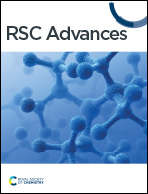Mechanisms of manipulating valley splitting in MoTe2/MnS2 van der Waals heterostructure by electric field and strains†
Abstract
In this study, we discuss the tunability of valley splitting using first-principles calculations with a monolayer MoTe2 and layered ferromagnetic MnS2 heterostructure as an example. We observe that, due to the magnetic proximity effect (MPE) at the interface, a monolayer of MoTe2 can exhibit a significant valley splitting of 55.2 meV. The production of the interlayer dipoles with spin-adapted configuration could be the origin of MPE at the interface. Furthermore, the valley splitting can be regulated continuously by the perpendicular electric field and biaxial strain. Interestingly, the valley splitting increases with the increasing induced magnetic moments in MoTe2 by applying an electric field while the inverse laws are presented by applying biaxial strains, which indicates that the mechanisms of valley splitting manipulating in these two ways are quite different. The calculation results suggest that the electric field influences the electric dipole distributions at the interface, which determines the induced magnetic moments in monolayer MoTe2, and results in valley splitting variations. However, biaxial strains not only affect MPE at the interface but also the intrinsic spin splitting caused by spin–orbital coupling (SOC) effects of monolayer MoTe2 itself and the latter is even the dominating mechanism of valley splitting variations.



 Please wait while we load your content...
Please wait while we load your content...